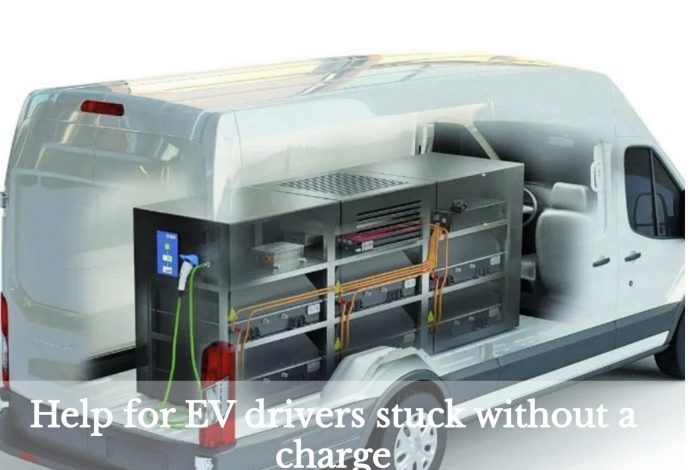A company called Blink Charging has found a solution to the problem of electric cars running out of electricity.
It is called gasoline.
Internally combusted.
The Miami-based company has built a “mobile charger” – which generates up to (the usual advertorial weasel wording) 9.6 kilowatts of juice by burning dead dinosaur (or algae bloom or abiotic, whatever you like) liquid juice. At peak output, it can instill up to a whole mile of range into an EV in a minute.
And it only costs $6,500!
(That’s a bargain – compared with the quarter-million dollars it takes to generate 80 kilowatts of portable electricity via the Lightning Mobile charger produced by Lightning eMotors of Colorado. )
As opposed to $3 for a gallon of gas – that instills 20-plus miles of range.
And which can be carried by hand to an out-of-gas car because it only weighs a few pounds. The Blink Charger weighs 350 pounds. The Lightning Mobile weighs 3,700 pounds and that requires a truck to haul it to wherever the stranded EV is.
So before you wait for the charge, you wait for the truck.
There will also be the cost, in the form of the recouping thereof. Assuming Blink isn’t a charitable enterprise, “investing” $6,500 of its own money in each portable IQ 200-M generators out of the generosity of its heart.
Probably, you are “investing.”
It is almost certain that Blink – the company – is the recipient of taxpayola in some form – perhaps “infrastructure” manna, raining from the heavens after being filched from the pockets of those who may not have an EV themselves but are certainly going to help fund (and recharge) them.
Even if not, someone will be charged – because no one “invests” $6,500 of their own money into a charger unless they expect to be able to charge for it, sufficiently so as to recoup their investment and then some – else it’s not an investment at all. And in that case, it cannot last because there is only so much loss that can be absorbed. A restaurant that doesn’t charge what it costs to serve the food it puts on the table will eventually not be able to put food on the table.
Putting electricity in an EV works on the same principle.
So, how much will it cost the EV owner to have this gasoline-generated electricity put into his EV? Bet your bippie it’ll cost more than $3 for a gallon of gas.
Why not just cut out the middle man? Put the $3 gallon of gas directly into the car – and forget the electricity altogether?
Because the electric car must be coddled and rationalized and supported by any means necessary, however absurd and however expensive. Because electric cars are “the future,” as decreed by those who stand to profit from them, in terms of money forcibly extracted by government and handed over to those who manufacture EVs and their peripherals, such as gas-burning portable chargers to keep get them moving again (briefly) when they stop moving.
And actually decreed, by law. By the government, which also stands to profit from their confected existing – via the control it acquires over people’s decreased freedom of mobility, which EVs reduce.
As well as limit.
Electric cars are also electronic cars – much more so than gasoline-burning cars. Especially older gasoline-burning cars, which are fully independent of wireless control and will run as long as they have fuel – which is longer (and farther) than any electric car can run.
Especially in a confected emergency.
Electric cars can be turned off anytime – even when fully charged. Not because they are electric but because they are electronically tethered – wirelessly – to the invisible cord that is always connected. The cord that can be pulled at the whim of the company that owns the software that runs the electric car and so is the true owner of the electric car (read your EULA; note that you are a user and not the owner of what you imagined to be “your” EV). And the government controls the corporations that control the EV. Or the reverse; it is functionally the same thing.
When these “private businesses” decide to enforce whatever the government says they must – such as proof of Jab, for instance – you will discover who the owner of your electric car really is. By discovering how far you’re allowed to go.
Which is why it does not matter – or rather, that so many pretend not to notice – that the Blink Charger generates electricity . . . by burning gasoline, the avoiding of which is allegedly the whole point for getting rid of gas burning cars in favor of electric cars.
But then, that is not actually the point at all. It is merely the pretext. The facade temporarily erected to hide the truth, which is that electric cars are being pushed for the same reason that Diapering was pushed . . . to advance another thing.
In the case of Diapers, it was always Needles. In the case of electric cars, it is no cars. This will become obvious, shortly. But most don’t see it, just as they didn’t see that effacing their faces was merely the prelude to extending their arms.
It doesn’t take a rocket scientist. But it does take open eyes – and an operating brain. It is unfortunate that both seem in such short supply.
. . .
Got a question about cars, Libertarian politics – or anything else? Click on the “ask Eric” link and send ’em in!
If you like what you’ve found here please consider supporting EPautos.
We depend on you to keep the wheels turning!
Our donate button is here.
If you prefer not to use PayPal, our mailing address is:
EPautos
721 Hummingbird Lane SE
Copper Hill, VA 24079
PS: Get an EPautos magnet or sticker or coaster in return for a $20 or more one-time donation or a $10 or more monthly recurring donation. (Please be sure to tell us you want a magnet or sticker or coaster – and also, provide an address, so we know where to mail the thing!)
My eBook about car buying (new and used) is also available for your favorite price – free! Click here. If that fails, email me at [email protected] and I will send you a copy directly!













‘Electric cars can be turned off anytime – even when fully charged. Not because they are electric but because they are electronically tethered – wirelessly – to the invisible cord that is always connected.’ EP
It is my meager understanding of Tesla EV’s, that the Tesla Mother Ship can disable another Tesla at anytime, and make it immobile. But, what happens to a Tesla when it loses contact with the Mother Ship for an extended period of time? Does it become inert if it cannot communicate back to the Mother Ship at least once a day? Are other EV’s like Leaf’s at the whim of their Mother Ship too? What happens if the WEF succeeds with their scheme to crash the Internet, WI-FI, Cell Towers etc. this Summer/Fall? Will the Tesla’s Leaf’s etc still function if they can be re-charged, but not able to communicate with their respective Mother Ships? I could care less as I would never own an EV, but am curious to know their fate.
Hi Rush,
My understanding is that they are “connected”- ostensibly for the purpose of receiving “updates,” such as new programming governing recharging the battery pack (and in the case of Teslas, to turn on or off certain electronic “options,” such as self-driving). Whether they would go inert if they were no longer “connected” – if the Mother Ship crashes – is something I don’t know. I suspect they’d be like a cell phone that no longer has signal and can’t make a call. It would turn on, but some of the functions would not function.
Thought yous guys might enjoy this take:
Don’t be silly; electric cars aren’t supposed to *work*
A lot of people expend a lot of energy trying to prove that electric cars don’t work and can’t work as a means of mass transportation to replace the internal combustion engine…
But of course they don’t work!
They aren’t intended to replace petrol- and diesel- powered mass transportation, but to abolish it.
[…]
https://charltonteaching.blogspot.com/2021/06/dont-be-silly-electric-cars-arent.html
I thought I lived far enough away from the city’s electric juice needles but was surprised to see a Tesla pass me on the road the other day. I figured it was some rich person who moved here thinking they were showing off for the locals whom don’t care one whit. But then I read in the paper (online) that my town has installed electric juice needles. I’m sure tax payer funded in some way but I know it is because our county has a huge tourist town that attracts all types and the money they bring, that this is a way to top off Teslas heading into our tourist trap and be able to do their thing and top off on their way back home so as to get the range needed to get back to the city’s needles.
Hi Eric,
When I first saw those Domino’s Pizza ads for “driverless delivery” in robot cars, I thought it was a joke commercial. Apparently not:
https://www.msn.com/en-us/news/technology/dominos-just-launched-a-driverless-robot-delivery-program-in-texas/ar-BB1fzWv0
I believe the govt. will push toward “driverless” everything— driving is just too dangerous for mere *humans* to handle! If we want to move from place to place, we’ll probably have to be shuttled around — like schoolchildren — in driverless vehicles.
Chris,
Yeah, wait until they find out those strange ovular vehicles ARE the Noid!
I can’t wait to see how many pizzas they eject all over the streets, how many accidents are caused, how many Domino’s patrons are run down…
Or, having schlepped pizza back in the bad ol’ days…
Will they send these driverless vehicles into the Ghetto? Since likely the payment is already made online, nothing to rob, save for the food. I’ll assume that each order is in its’ own compartment. I’d say, if anything, the vehicle itself is the target.
OR…will some “activists” decry Domino’s if they redline out the Ghetto for delivery?
I’m beginning to think that the ‘driverless’ BS is just a scheme to make low IQ companiers waste money/transfer it to Silly-CON Valley. A lot of the companies who had been playing with driverless, have abandoned the idea as of late- including Uber. Apparently, even the half-sane ones are realizing that it’s not going to work….at least not without some very specialized ubiquitous infrastructure. Even freakinbg Tesla is dialing back the auto-pilot nonsense…..
Eric,
I read something recently where Toyota is expecting 85% of its vehicles to still have tailpipes in 2030. The ICEV isn’t dead yet!
Any car company that wants to be able to sell cars in 2030 is going to have to have tail pipes on most of it’s vehicles. That includes companies that have announced they are phasing out ICE by 2030. There is NO way to phase out ICE in 8 models years. NO WAY!
Can you imagine a farmer dragging half a mile or more of very heavy extension cord out to his dead electric combine? Of course by that time, if Bill Gates has his way, we won’t need to farm because we all eat synthetic food.
Why not just hang catenary lines on every road? Talk about infrastructure! Then we can put pantographs on Teslas.
‘Electric cars can be turned off anytime – even when fully charged.’ — EP
If we’re in the fast lane to the Third World, one should plan ahead for the blackouts of power and water grids that are a routine feature of daily life in many places.
Throughout Latin America, houses have water tanks on the roof, to provide a reserve when the dodgy municipal water supply goes down.
Here in Bidenstan, I once had a gas furnace with a millivolt generator — a tiny turbine spun by the flow of gas to the pilot light — powering the thermostat. No electric supply needed to keep the heat on!
When the old furnace had to be replaced, the new one required 120 VAC power both for the thermostat and for a solenoid-operated flue damper. Oops — no power, no heat! I still kick myself for not seeing that coming.
Electric utilities — hidebound stegasauri, whose incompetent management was on bright-neon display in the 1970s as Soviet-style nuclear projects went wildly off the rails — are licking their lips over getting a monopoly on household energy supply. No one in their right mind would let that happen.
Naturally, Commiefornia leads in forbidding natural gas hookups to new houses, despite natgas being plentiful, cheap and competitive with electric power. Neighboring states such as Arizona and Nevada, eyeing with alarm the marxist malignancy to their west, already have passed state laws forbidding their municipalities from drinking the Kalifornia Kool-Aid of stewing in the dark (or freezing in the cold) every time the damned wind blows.
Cuckoo … cuckoo …
Jim….
After 9/11 we had an electrician install a transfer box for a portable 3,600 watt generator. The first breaker is dedicated to powering our gas furnace.
So, riddle me this… Why can I find an “up-to” 9500 watt generator, in 3 seconds, that costs $1,800 ($4,700 less than this Blink charger) and also weighs nearly a 100 lbs less? Am I missing something?
https://www.harborfreight.com/generators-engines/generators/9500-watt-super-quiet-inverter-generator-with-co-secure-technology-57080.html
I think the thing I hate most about “green energy” is the grifty sales-force.
It’s because generators like this one aren’t very good at maintaining a stable voltage and A/C waveform. They’re fine for powering “dumb” things like motors or welders or incandescent light bulbs, which don’t care, but when you connect them to fancy electronics, which assume a well regulated A/C supply, you could damage them.
OpLock,
They state “Pure sine wave inverter technology safely powers sensitive electronics such as smartphones, laptops, TVs” in regards to the $1,700 generator…
Also, how difficult would it be to make an alternator with a well regulated RPM? That wouldn’t require an inverter at all.
In short, I call BS on their (Blink’s) pricing.
But Blink’s units are GREEEEEN! -They only emit recycled gay unicorn farts while playing anti straight white capitalist male slogans on a loop in perpetuity.
The one in the link is an inverter generator. A drop in engine speed isn’t going to cause by itself a drop in voltage or frequency…actually, they usually throttle back under partial load to make less noise and burn less fuel. It has electronics on board (that’s the inverter, which generally speaking is a device to convert DC to AC) to take whatever the engine produces at a given speed and converts it to the specified output.
Right. Inverters aren’t all made equal. You should see how horrific the A/C looks from those generators on a spectrum analyzer. The Blink device is overpriced, no disagreement there.
**”At peak output, it can instill up to a whole mile of range into an EV in a minute. And it only costs $6,500!”**
What an age we live in!
I took it that these devices were intended for creating a whole cottage industry of roving roadside car charging vehicles. How much do you think they’ll charge a stranded motorist for each 1 mile of juice they dispense?
maybe – someone can make an electric generator that fits in that front trunk space freed up in electric cars……
And we can give it a really cool name, like, engine.
Hi Anon,
“maybe – someone can make an electric generator that fits in that front trunk space freed up in electric cars……”
Someone did, Chevy engineers. The result being the Volt, a brilliant car, and the only EV that makes any sense. It combines the convenience of an EV for daily commuting and the practicality of an ICE for long distance driving. It can be fully charged overnight on standard household equipment, gets 35-50 miles of pure EV range (more than enough for most commuting needs) and doesn’t demand a new, redundant nationwide infrastructure to operate practically. So, of course, the only sensible, full purpose, EV has been canned in favor of long range pure EV’s. Which, if widely adopted, will require a massive increase in generating capacity, and huge changes in residential and commercial infrastructure. Curious how the “environmental costs” of the massive, and necessary (to make EV’s even poorly approximate the practicality of an ICE), infrastructure changes is never discussed by the mainstream media and the PTB. It’s almost like “saving the planet” is not the real goal.
Cheers,
Jeremy
I’ll second the volt as the only practical type of EV
ev is good only for short drives anyway so a backup needs to be built in
but is the point to make sure we can’t get away from the stasi ? if so EV is perfect to keep you where you belong
maybe it’s less meniacal – long trip? ditch the car & take the train or bus or other public transit
that is one of the wet dreams of the euro wannabees
anyway, you can tell what the real deal is if you see ev police cars, fire trucks, and ambulances – or not
Hey Dan,
I picked up a pristine 2013 Volt for $6950.00. I got $6000.00 in trade for a beat 2012 Pious. The Volt is a vastly superior car! Lucky for me, the Volt is undervalued and the Prius is overvalued in the minds of many.
Cheers,
Jeremy
I work in the rotating equipment field. The inefficiencies that this represents is absurd.
Many years ago the variable frequency drive was becoming mainstream in my industry. People all thought that be turning the speed down of a motor, and therefore reducing HP saved electrical operating costs. It’s not true in the large majority of applications. I prove it to engineers/operators all the time.
Reducing speed with a VFD will certainly reduce horsepower, and (usually) consumed power, and (usually) operating cost. However it is not a strictly linear relationship. There are very good reasons for VFD’s, but energy savings is grossly overhyped. Much like LED lights- yes they use less power, but the light load in a typical house is a small fraction of the total household load including water heater, stove, maybe heating.
Also, if they’re going to do this, why not use a small diesel for better safety and fuel efficiency?
Probably because logic and reason are undesirable in the face of propaganda.
That’s exactly why I decry this promotion of dedicated EVs like the Telsa line, as the current state-of-the-art of battery and motor technology still results in a vehicle with limited range, functionality, and significantly higher cost…for WHAT benefit, other than some intangible emotion of “do-goodism” that one’s ride somehow brings about a lesser impact on the environment than the traditional ICE vehicle, or even a HYBRID?
Sure, for a vehicle that can be worthwhile with the short range and lengthy recharge time, like a local delivery or taxicab vehicle, or a dedicated “commuter” and/or “grocery getter”, an EV makes sense. However, if trading away the flexibility and practically “unlimited” range (the limits being one’s finances, availability of fuel, and roads or suitable driving surfaces, and, ultimately land itself and the Earth’s circumference) of the ICE vehicle was worth it, then there’d ALREADY be a market for it, RIGHT? That there needs to be government subsidies, tax credits, and virtue-signaling propaganda should make it self-evident that EVs are still not typically a practical vehicle.
As for the hybrids, I’ve envisioned where, instead of the traditional gasoline engine, if fuel economy and environmental impact are really the objective, to use a small DIESEL engine, but run it exclusively for charging the battery and/or supplying the juice to the drive motors. The advantages would be several:
(1) Diesels are, by nature of operating in excess of theoretical air for combustion, inherently clean of CO and HC. This does result often with high NOx, but diesels are usually amendable to an EGR system to rectify that.
(2) Since the diesel is not directly coupled to the drive wheels, there’s no need for the weight or expense of a transmission and/or differential. Also, it can run at a single speed, and it’s bore, stroke, and tuning be optimized to that speed. This will maximize engine efficiency. Also, since the diesel’s reason is to simply drive a generator (which doubles as its starting motor), it can be smaller than what’d be necessary to power the vehicle in conventional fashion.
(3) Such an arrangement in a pickup truck or SUV would offer an easy PTO arrangement, as well as electric power for portable equipment.
(4) Of course, making this thing a plug-in hybrid would optimize its utility. Provided hooking up to one’s domestic power is still cheaper than fuel, a nightly recharge may suffice for daily commuting or errands w/o any need to fire up the diesel. The engine would only be needed for periods of heavy energy demand (like running the A/C on hot days, driving up hills, or long trips). As long as some oil and fuel quality monitoring is included, such an engine should render very long life, on the order of 25 years and/or 500K miles. It would boil down to a decision by the manufacturer as to whether to use “planned obsolescence” to avoid spiking future sales.
There is no limit to the amount of money it might take to force a bad idea to work. It could bankrupt a government even if it wasn’t already bankrupt. And STILL not work. A sane intelligent person tries new ideas. If it doesn’t work, they abandon it and move onto something else. The OCD psychopath on the other hand CAN’T give up, because they are obsessed. They will attempt to force it to work if it takes every dime you have.
Governments have a time-honored means of bankrupting themselves and causing widespread destruction and chaos…it’s called WAR.
In the olden days, a king got his loyal noblemen and knights to fight for him, not necessarily because his was the King (often, they hated his guts, and he had to watch his royal ass for plots on his life), but with the promise of BOOTY (and yes, THAT kind of “booty” was a wee inducement, but most counts, dukes, and so on were more concerned about gold and other valuables, and LAND). That is, you went to war expecting to PROFIT (and LIVE, of course, no matter their religious superstitions, they understood that you couldn’t take your wealth with you), which in the past 200 or so years, we’ve been too “enlightened” to do. We can wreak havoc and kill people in industrialized fashion, so we can do as Conan said was “good”, to crush our enemies, drive them before us, and hear the lamentations of their women, but we won’t rape their females nor carry off their stuff. And if we won’t, well, what’s the point of fighting?